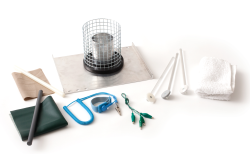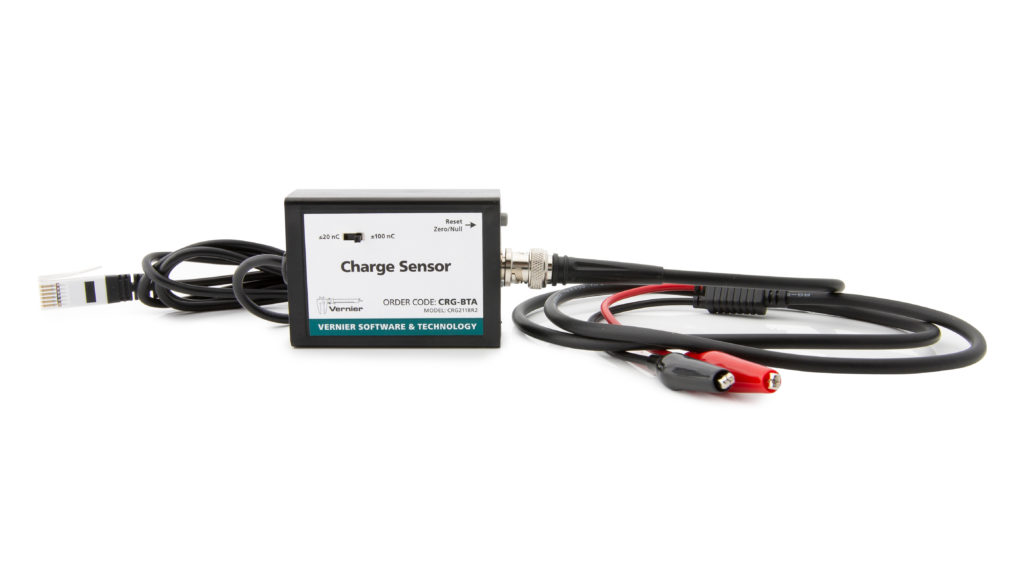Charge Sensor User Manual
Order Code: CRG-BTA
The Charge Sensor is used as an electronic electroscope. Unlike a traditional electroscope, the Charge Sensor can make quantitative measurements. Numerical measurements improve many electrostatics experiments, such as charging by induction, charging by friction, and charging by contact. The sensor can also be used to measure charge polarity.
An extremely high impedance voltage sensor with a 0.01µF input capacitor makes these measurements possible. The sensor has two operating ranges and a zeroing switch to discharge the input capacitor.
Note: Vernier products are designed for educational use. Our products are not designed nor recommended for any industrial, medical, or commercial process such as life support, patient diagnosis, control of a manufacturing process, or industrial testing of any kind.
Compatible Software and Interfaces
Choose a platform below to see its compatibility requirements.LabQuest
Interface LabQuest App LabQuest 3 Full support LabQuest 2 Full support LabQuest Full support Computers
Software Interface Graphical Analysis Graphical Analysis (Web App) Logger Pro (discontinued) Logger Lite (discontinued) LabQuest Mini Full support Full support Full support Full support LabQuest 3 Full support Full support Full support Incompatible LabQuest 2 Full support Full support Full support Full support LabQuest Stream Full support 1 Full support 1 Full support Full support 1 Go!Link Full support Full support Full support Full support LabQuest Full support Full support Full support Full support LabPro Incompatible Incompatible Full support Full support Compatibility Notes
Chromebook
Software Interface Graphical Analysis (Web App) LabQuest Mini Full support LabQuest 3 Full support LabQuest 2 Full support LabQuest Stream Full support 1 Go!Link Full support LabQuest Full support Compatibility Notes
iOS
Software Interface Graphical Analysis Graphical Analysis GW LabQuest Stream Full support Full support LabQuest 3 Full support 1 Full support 1 LabQuest 2 Full support 1 Full support 1 Compatibility Notes
Android
Software Interface Graphical Analysis Graphical Analysis GW LabQuest Stream Full support Full support LabQuest 3 Full support 1 Full support 1 LabQuest 2 Full support 1 Full support 1 Compatibility Notes
Arduino
Software Interface Arduino Vernier Arduino® Interface Shield Full support LabVIEW
Software Interface NI LabVIEW SensorDAQ Full support Vernier myDAQ Adapter Full support 1 Go!Link Full support LabQuest Mini Full support LabQuest Stream Full support LabQuest 3 Full support LabQuest 2 Full support LabQuest Full support Compatibility Notes
Texas Instruments
Software Interface EasyData DataMate TI-84 SmartView DataQuest TI-Nspire Software EasyLink Full support 1 Incompatible Full support 2 Full support Full support 2 CBL 2 Full support 3 Full support 3 4 Incompatible Incompatible Incompatible LabPro Full support 3 Full support 3 4 Incompatible Incompatible Incompatible TI-Nspire Lab Cradle Incompatible Incompatible Incompatible Full support Full support Compatibility Notes
Quick Start
- Plug the sensor into the interface (LabQuest 3, LabQuest Mini, etc.).
- Connect the interface to your device.
- If using USB, connect to the USB port on your computer.
- If using Bluetooth® wireless technology, click your interface type and then select your device.
- Prepare for data collection:
- Vernier Graphical Analysis®: Launch the app, if necessary, and click Sensor Data Collection.
- LabQuest® App: Choose New from the File menu.
The software will identify the sensor and load a default data-collection setup. You are now ready to collect data.
Need Additional Information?
Visit the following link:
Using the Product
Connect the sensor following the steps in the Getting Started section of this user manual.
General Tips
- When the sensor is stored, it is a good idea to short together the leads in order to protect the sensor from high static potential that could damage the unit.
- Press the Reset button for a few seconds to zero the sensor.
- Pressing and releasing the Reset button with the leads connected to a voltage source such as a power supply or battery will cause an error in the reading and is not recommended, because it will short the power supply as well.
- Since the sensor is capable of measuring very small amounts of charge, it is critical to begin experiments by zeroing the sensor.
- You must be careful when handling the leads or you may alter the readings with stray charge. The insulator on the clip lead quickly becomes oily from handling, and fingers often carry small amounts of charge at high potential that can easily leak through the insulator and affect your reading. The best way to minimize this is by grounding your fingers, or wearing a grounding strap on your wrist, to remove any charge before releasing the positive lead from its ground connection. Start recording data before removing the lead from ground so you will be aware if any stray charge accumulates before making your connection. When connecting to static sources (not a fixed voltage like a battery), the Reset button can be used while connected to a passive charge receptor. Make sure the output reads zero after reset.
- The sensor is not differential; therefore the negative (black) side is always at ground potential. The supplied cable is shielded and has a low leakage dielectric. When using other cables, the unit should be tested to make sure the cable does not allow excessive leakage currents
- The negative (black) lead is the ground connection. The effects of stray static charges will be minimized by connecting the black lead to a metal ground plane below your experiment, such as a sheet of aluminum foil.
- Synthetic clothing can carry significant charge, as can the experimenter’s body. Grounding the experimenter by using a ground strap on one wrist will help.
- When not using a Faraday Pail and ground plane, it helps to connect a metal cup to the positive (red) lead. This cup adds negligible capacitance to the system, but makes it easy to see induced or deposited charges. Insulate the cup from the ground plane using a glass jar or beaker. Plastic does not work well because it will accumulate stray charge quickly.
- Complete all experiments quickly. Due to leakage currents in the cable and apparatus, the reading will rarely be reliable after 15 seconds.
Tips for Use with a Faraday Pail and Ground Plane
- Use of this sensor is simplified with the aid of a Faraday pail and ground plane such as found in the Vernier Electrostatics Kit (ESK-CRG).
- Since the sensor is capable of measuring very small amounts of charge, it is important to begin experiments by zeroing (resetting) the sensor. Simply press the Reset button on the sensor for a few seconds to zero the equipment. (Pressing the Reset button, internally shorts the leads, shorts the internal input capacitor and the internal integrator capacitor.)
- The sensor should be zeroed after initial power up.
- The sensor must be zeroed whenever a new range setting is chosen.
- During data collection, monitor the sensor reading. If an excess charge develops on the sensor, zero the sensor prior to a new data-collection run.

Experiment Ideas
- Use the sensor with a Faraday pail to investigate charging by induction. Bring a charged object near the pail. What charge is measured? Ground the pail and remove the charged object. What charge is measured?
- Use a Faraday pail to investigate charging by contact. Do this by dropping a charged object into the can. All of the charge on the object will be transferred to or induced in the can.
- Without a grounding strap, scuff your feet on carpet or pull off a sweater. Hold your hand near a Faraday pail. Do you induce a charge? What sign? Does a ground strap remove or reduce this effect?
- Charge various objects and determine the sign of the charge.
- Measure how quickly objects lose charge. Plot the charge as a function of time; this will take some minutes on a dry day.
- Use the Charge Sensor and Faraday pail to observe the separation of charge when two strips of invisible tape are pulled apart. On two 3 inch pieces of tape, make a tab by folding over the top of each. Stick the combination to the table top. Pull the combination off the table and run your thumb or finger along the smooth side of the tape to neutralize the combination. Then pull the top strip off the bottom strip. Individually insert each strip into the Faraday pail to measure the charge. Simultaneously insert them in the pail to measure the charge.
- Charge a Faraday pail by contact on the inside; add more charge. How much charge can you add from the inside of the can? Can you add as much from the outside? More? Less? Investigate.
- Use a second pail (not connected to the red lead as a detector) and charge it by induction. Do this by charging an insulating object, holding it inside the pail (inducing a charge on the outside of the can) and then briefly grounding the pail. Remove the charged insulator, and you’ve got a charged pail. Measure the charge by testing it by induction, or by touching it to the inside of the detector pail.
Many of these tips are based on suggestions from Robert Morse, Ph.D.
Videos
Calibration
You do not need to calibrate the Charge Sensor. We have set the sensor to match our stored calibration before shipping it. You can simply use the appropriate calibration file that is stored in your data-collection program from Vernier.
Stored Calibration Values
|
±2 V setting in Volts |
slope: 1.0 intercept: –2.5 |
|
±2 V setting in nC |
slope: 10.0 intercept: –25.0 |
|
±10 V setting in Volts |
slope: 3.3 intercept: –8.25 |
|
±10 V setting in nC |
slope: 33.0 intercept: –82.5 |
Specifications
|
Ranges: |
±2 V (±20 nC) ±10 V (±100 nC) |
|
Maximum input: |
±150 V |
|
Typical bias input current: |
0.005 pA |
|
Instrument time constant: |
0.1 s |
Care and Maintenance
Do not wrap the cable tightly around the sensor for storage. Repeatedly doing so can irreparably damage the wires and is not covered under warranty.
How the Sensor Works
The Charge Sensor is an extremely high impedance voltage sensor with a 0.01 μF capacitor in series with the input. The capacitor will accumulate charge until the source’s voltage is reached, i.e. equilibrium is achieved. Small amounts of charge can be measured even though their initial potential is higher than the input range of the sensor. The input circuit also includes a 1 MΩ resistor in series with the capacitor to protect the unit from large current surges. When used with a data-collection interface, connected by USB to a computer, or to an interface connected to AC power, the negative polarity (black) input lead is grounded to Earth.
Troubleshooting
For additional troubleshooting and FAQs, see www.vernier.com/til/1427
Repair Information
If you have watched the related product video(s), followed the troubleshooting steps, and are still having trouble with your Charge Sensor, contact Vernier Technical Support at support@vernier.com or call 888-837-6437. Support specialists will work with you to determine if the unit needs to be sent in for repair. At that time, a Return Merchandise Authorization (RMA) number will be issued and instructions will be communicated on how to return the unit for repair.
Accessories/Replacements
| Item | Order Code |
|---|---|
|
ESK-CRG |
|
|
HVEK-CRG |
|
| Electrostatic High-Voltage Genecon |
HVEK-GEN |
Warranty
Warranty information for this product can be found on the Support tab at www.vernier.com/crg-bta/#support
General warranty information can be found at www.vernier.com/warranty
Contact Support
Fill out our online support form or call us toll-free at 1-888-837-6437.

